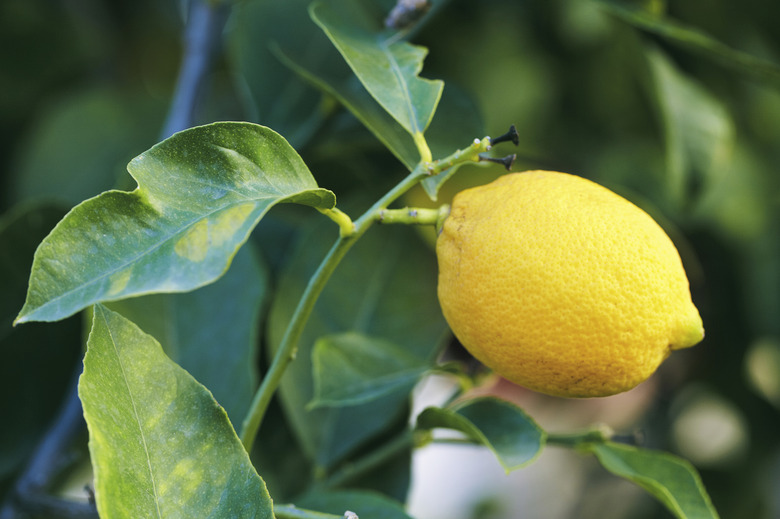Animals That Eat Lemons Or Lemon Tree Leaves
Lemon trees (Citrus limon) are unusual in that they can produce new growth throughout the year. Even though there's a steady supply of tender new leaves, flower buds and blossoms, lemon trees ordinarily aren't bothered by many critters that feed upon them. A few mammals and some insects can cause damage. If you're growing lemons indoors in cold winter areas, below U.S. Department of Agriculture plant hardiness zones 8 through 11, insect pests are more likely.
Jackrabbits and Cottontails
Usually rabbits cause damage to young trees that have thin trunks, tender bark and branches low enough for them to reach leaves and buds. They'll eat leaves and stems and gnaw bark as well. Jackrabbits are larger than cottontails, with long ears and large hind legs. They live in the western and central U.S. and frequent more open spaces, rarely coming into urban areas. Cottontails have shorter ears and usually live in brushy areas and woodlands, even in towns.
- Lemon trees (Citrus limon) are unusual in that they can produce new growth throughout the year.
- Usually rabbits cause damage to young trees that have thin trunks, tender bark and branches low enough for them to reach leaves and buds.
Rabbit Damage
Because rabbits feed at night, you won't usually see them eating your plants. Instead, look for the chew marks they make. Rabbits, especially jackrabbits, can stand on their hind legs to reach up the tree trunk. Look for neatly clipped off branches that are stripped of their leaves and buds. Round rabbit droppings are also a sure sign.
Protection Against Rabbits
The only sure way to protect lemon trees from jackrabbit or cottontail damage is to fence the trees. When lemon trees are 4 to 5 years old, rabbits generally don't bother them. Until then, make a tree guard for a single tree by forming an 18-inch-wide cylinder of 1-inch mesh poultry netting that's 3 1/2 feet tall for jackrabbits and 2 1/2 feet tall for cottontails. Bury 6 inches of the cylinder in the ground. To prevent rabbits from bending in the wire to reach the tree, pound three lengths of 4-foot-long iron rebar 12 inches into the ground. Space the rebar equally around the tree, just inside the wire netting, and fasten the netting to the rebar with short lengths of baling wire.
- Because rabbits feed at night, you won't usually see them eating your plants.
- The only sure way to protect lemon trees from jackrabbit or cottontail damage is to fence the trees.
- When lemon trees are 4 to 5 years old, rabbits generally don't bother them.
Roof Rats
If you find a lemon still on the tree with all the rind chewed off, you've been visited by a roof rat. Smaller and sleeker than a Norway rat, roof rats are gray above and white below. They live in warmer areas, such as near the Gulf and on the Pacific Coast and they eat citrus fruits of all kinds. They're good climbers and often live in attics and outbuildings as well as in trees and along streams.
Discouraging Roof Rats
Find and eliminate roof rat habitat near lemon trees. You can try to limit rat access to the lemon trees by isolating them from nearby vegetation or structures that roof rats can leap from to reach the trees. Because lemon trees can have branches close enough to the ground for roof rats to easily climb into, prune off lower branches to raise the canopy. To reduce the rats' food supply, keep fallen fruit off the ground. When pruning, use shears that have been wiped with a cloth soaked in rubbing alcohol. This helps prevent the spread of disease.
- If you find a lemon still on the tree with all the rind chewed off, you've been visited by a roof rat.
- Because lemon trees can have branches close enough to the ground for roof rats to easily climb into, prune off lower branches to raise the canopy.
Orange Dog Caterpillars
A large, conspicuous caterpillar that you might see on lemon tree leaves as well as on other citrus, the orange dog caterpillar turns into the showy, black and yellow giant swallowtail butterfly. The butterfly lays eggs on lemon leaves in spring, and caterpillars eventually become 1 1/2 to 2 inches long. They're colored gray, brown, cream and tan and resemble bird droppings. Mature trees usually aren't harmed, but small trees can suffer significant leaf loss from just a few caterpillars. Hand-pick them from young trees as soon as you see the caterpillars.
Container Trees
Lemon trees indoors tend to have problems with insects. Aphids are soft-bodied, pear-shaped insects about 1/8 inch long, usually green, yellow, black or gray. Mealybugs are grayish, often mealy or fuzzy-looking oval insects that fasten to leaves and stems. Look for whiteflies on leaf undersides. The tiny white insects are winged as adults. All these insects suck sap. Monitor your lemon tree frequently. As soon as you see pests, rinse them off with a strong spray of water or wipe them off with cotton swabs soaked in soapy water.
- A large, conspicuous caterpillar that you might see on lemon tree leaves as well as on other citrus, the orange dog caterpillar turns into the showy, black and yellow giant swallowtail butterfly.
- The butterfly lays eggs on lemon leaves in spring, and caterpillars eventually become 1 1/2 to 2 inches long.
